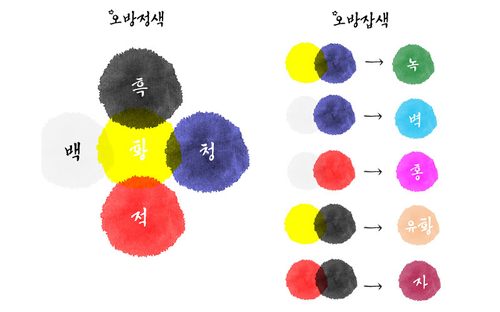When looking at Korean traditional clothing, art, and food, it’s not hard to notice that some colors seem to be repeated more than others. You’d be right, in fact, in thinking that a certain spectrum of colors holds a specific significance in Korean history and tradition. Read on to find out more about the Korean color symbolism.

There are five colors – known as ‘O-Bang (meaning ‘five direction’) Saek (meaning ‘color’) – which are considered especially significant as Korean color symbolism.
These five colors are blue, red, white, black, and yellow. You will find these colors to be prominent in ‘Hanbok’ (Korean traditional attire), Korean paintings, musical instruments and festivals, architecture, flags and traditional symbols, and of course – Korean food!
Not only do the five colors represent directions: east (blue), south (red), center (yellow), white (west) and north (black), they are also said to symbolize the ‘five elements of life’ according to traditional Korean teaching. The five elements of life are wood (blue), fire (red), earth (yellow), metal (white) and water (black). All of these elements – and all of these colors – were considered necessary for a healthy, prosperous, and long life. More recently, green has also come to be used commonly alongside the five original colors.
Below you can see some of the ways ‘obangsaek’ colors (the colors of Korea) were mixed to create pinks and greens – also common across Korean traditional art and culture.
These five colors, five cardinal directions, and five elements of life, originated from the ancient Chinese philosophical theory of Yin and Yang, which believed that everything in life must be balanced, according to these five movements.
Adhering to ‘obangsaek’ in Korean cooking was – and is – thought to ensure a healthy meal, both physically and spiritually. Eating a meal containing all five colors of ‘obangsaek’ (with ‘blue’ often substituted for green) was thought to be nutritious for all five vital organs of the body, while maintaining balance in life.
Interestingly, many, many, years later, modern day Western nutritionists also began to recommend eating five different colors fruits and vegetables a day, to ensure a balanced diet!
One of the best-known Korean foods to incorporate ‘obangsaek’ is bibimbap.
Other foods which adhere to the ‘obangsaek’ color spectrum are kimbap, gujeolpan, and japchae.
Tangpyeongchae – a popular noodle dish in traditional Korean court cuisine – also followed the ‘obangsaek’ principle. You will find, too, that many soups in Korea are served with ‘obangsaek’ colored toppings sprinkled on them.
In addition, most Korean side dishes, or ‘ban chan’, follow the obangsaek rule. Next time you eat at a Korean restaurant, take a look at your side dishes, and see how many red, black, white, green, and yellow ones you can find!
Of course, using ‘obangsaek’ as a guide when preparing a meal, helps insure that you’re consuming a balanced diet, full of colorful vegetables and ingredients. For more information about ‘obangsaek’ click here. For a healthy ‘obangsaek’ lunchbox recipe, click here.
Gastro Tour Seoul offers customized tours exploring all aspects of Korean traditional cuisine. For a fun, informative, and delicious experience of Korean food culture, contact info@gastrotourseoul.com
